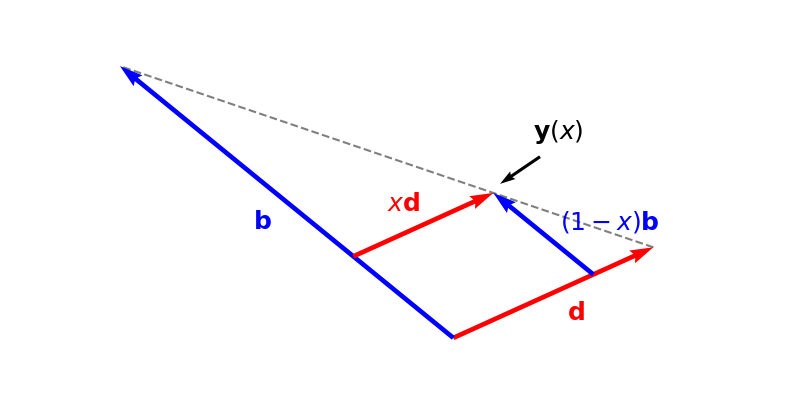The locus of all convex combinations of two points is the line between them. This is easy to visualize in two dimensions. Consider the linear equation
y(x)=mx+b(1)
where m is the slope of the line and b is the bias or y-intercept. We can rewrite this as
y(x)=mx+b=x[m+b−b]+b=x(m+b)+(1−x)b.(2)
This equation is a linear combination of two points, (0,b) and (1,m+b). When 0≤x≤1, the equation is a convex combination of the two points and defines a line between them. When x≤0, the equation traces a line to the left of (0,b). When x≥1, the equation traces a line to the right of (1,m+b) (Figure 1).
We can extend this visualization to arbitrary dimensions. Consider a vector y(x) that is the convex combination of two vectors d and b:
y(x)=xd+(1−x)b,0≤x≤0.(3)
We could visualize this as vector addition. As x varies between zero and one, the two vectors xd and (1−x)b add to produce a new vector y(x) (Figure 2).
Another way to visualize this is to use Equation 1. Let’s rewrite Equation 3 as
y(x)=xd+(1−x)b=xd+(1−x)b+xb−xb=x(d−b)+b.(4)
(Clearly, a vector m could be defined as m≜d−b.) Now we can think of y(x) as simply a fraction of the vector subtraction d−b plus b (Figure 3). While Figure 3 is not a proof, I think it provides useful intuition: as x ranges between zero and one, the vector x(d−b) ranges between the two end points defined by b and d. The vector y(x) is just this fractional distance plus b.
Now that we some geometric intuition, let’s prove that y(x) must be on the line between b and d. First, let’s compute the distance between b and y(x):
∥b−y(x)∥=∥b−[x(d−b)+b]∥=∥−x(d−b)∥=∣x∣∥(b−d)∥=x∥b−d∥.(Equation 4)(x≥0)(5)
Next, let’s compute the distance between y(x) and d:
∥y(x)−d∥=∥xd+(1−x)b−d∥=∥(x−1)d+(1−x)b∥=∥(1−x)b−(1−x)d∥=∣1−x∣∥b−d∥=(1−x)∥b−d∥.(Equation 3)(1−x≥0)(6)
Taken together, Equations 5 and 6 imply that the total distance is
∥b−y(x)∥+∥y(x)−d∥=x⋅∥b−d∥+(1−x)⋅∥b−d∥=∥b−d∥.(7)
Thus, y(x) must be on the line between b and d. Why? Imagine a triangle with vertices defined by b, y(x), and d (Figure 4).
Then the lengths of the sides would be
∥b−y(x)∥,∥y(x)−d∥,∥b−d∥.(8)
By the triangle inequality, the sum of the first two lengths can only equal the sum of the third if we have a degenerate triangle, i.e. the triangle’s vertices are collinear. So the three vertices b, y(x), and d must be collinear. Since we can easily verify that y(0)=b and y(1)=d, then the locus of points defined by y(x) is the line between b and d.



